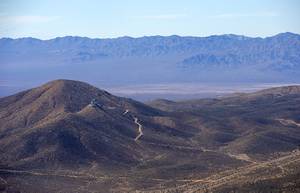Original article: https://m.lasvegassun.com/news/2020/feb/16/proposed-national-monument-south-las-vegas-boost/#.Xkki4kU5K_8.twitter
By Miranda Willson

Linda Otero isn’t used to thinking in terms of man-made borders and boundaries. As a member of the Fort Mojave Indian Tribe, she believes all of the natural world originated at Avi Kwa Ame, known in English as Spirit Mountain, extending continuously outward from the 5,600-foot peak near Laughlin.
But given that borders define the modern United States, Otero recognizes the need to establish them to protect places sacred to the Fort Mojave. That’s why the tribe and environmental organizations are advocating for the creation of the Spirit Mountain National Monument.
The proposed 384,000-acre monument along Nevada’s southern tip would create a bridge between Mojave National Preserve in California, Lake Mead National Recreation Area and other nearby protected areas. The region is rich in desert tortoises, Joshua trees, bighorn sheep and cultural resources for Yuman-speaking tribes like the Fort Mojave, said Alan O’Neill, retired superintendent of Lake Mead National Recreation Area.
“This entire landscape is a cultural landscape,” said O’Neill, also the founder of the Outside Las Vegas Foundation, now known as Get Outdoors Nevada.
Last month, the aspiration for a national monument in this area came one step closer to fruition. Sen. Catherine Cortez Masto, D-Nev., references Spirit Mountain National Monument in her draft Clark County lands bill, a long-awaited and controversial 64-page bill that would alter key development and conservation boundaries in Southern Nevada.
The proposed bill does not define the monument’s scope or significance, but advocates such as the National Parks Conservation Association are hopeful that the final legislation will establish the Spirit Mountain National Monument.
“This is really the vehicle of how to get this done,” said Neal Desai, senior director of field operations at the conservation association.
In addition to specific plants, animals and cultural resources, the national monument would preserve a rare Sonoran grassland, several natural springs and historic former mining sites. The area also includes the Walking Box Ranch, the well-preserved 1930s-era former home of actors Rex Bell and Clara Bow.
Attempts to protect the region have been ongoing since the 1990s, when Spirit Mountain was placed on the National Register of Historic Places because of its significance to Native Americans. As Lake Mead superintendent, O’Neill worked with nearby tribes to attain that designation, but they later realized that they could take those efforts further.
“We decided, ‘Let’s put our heads together and let’s look at a much bolder idea to protect this entire area and connect all of the preservation work that has been done on the California side,’” he said.
Such efforts were complicated by two proposed wind energy projects near Spirit Mountain that ultimately failed to move forward. Since the second proposal, the Crescent Peak Wind Energy Project, was rejected by the BLM in 2018, advocates say the time is ripe to establish the monument before another threat to the landscape arises.
“It’s important to do this while the opportunity exists,” O’Neill said.
The National Parks Conservation Association, Get Outdoors Nevada and others are working with leaders in Boulder City and Searchlight to gain support for the monument, O’Neill said. Tribes have also been and will continue to be involved in the process. In addition to the Fort Mojave and related tribes, Spirit Mountain is sacred to the Hopi of Arizona and the Chemehuevi Paiute of the southern Great Basin, Otero said.
“We see the strength of the mountain. It just endures throughout time and generations,” said Otero, director of the Aha Macav Cultural Society. “It’ll last forever.”
While tribes have seen the region as interconnected for decades, conservationists have recently come to see the land in that way as well. Migratory birds and desert bighorn sheep do not respect the boundaries of Lake Mead or the Mojave National Preserve and need this proposed connecting area to thrive, Desai said.
With the threat of climate change, it is also crucial that animals and ecological resources have room to alter their range, O’Neill said. The extensive mountains and valleys within the proposed national monument area would allow blackbrush, Joshua trees and other plants threatened by climate change to move to higher, cooler elevations if necessary.
“We don’t know what’s going to happen with climate change. We know that some of that habitat may shift up as we warm,” O’Neill said.